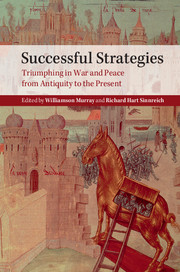Book contents
- Frontmatter
- Dedication
- Contents
- List of tables and map
- List of contributors
- Acknowledgments
- Introduction
- 1 The strategic thought of Themistocles
- 2 The grand strategy of the Roman Empire
- 3 Giraldus Cambrensis, Edward I, and the conquest of Wales
- 4 Creating the British way of war: English strategy in the War of the Spanish Succession
- 5 Failed, broken, or galvanized?
- 6 Victory by trial and error: Britain’s struggle against Napoleon
- 7 The strategy of Lincoln and Grant
- 8 Bismarckian strategic policy, 1871–1890
- 9 Dowding and the British strategy of air defense 1936–1940
- 10 US naval strategy and Japan
- 11 US grand strategy in the Second World War
- 12 American grand strategy and the unfolding of the Cold War 1945–1961
- 13 The Reagan administration’s strategy toward the Soviet Union
- Afterword
- Index
- References
13 - The Reagan administration’s strategy toward the Soviet Union
Published online by Cambridge University Press: 05 June 2014
- Frontmatter
- Dedication
- Contents
- List of tables and map
- List of contributors
- Acknowledgments
- Introduction
- 1 The strategic thought of Themistocles
- 2 The grand strategy of the Roman Empire
- 3 Giraldus Cambrensis, Edward I, and the conquest of Wales
- 4 Creating the British way of war: English strategy in the War of the Spanish Succession
- 5 Failed, broken, or galvanized?
- 6 Victory by trial and error: Britain’s struggle against Napoleon
- 7 The strategy of Lincoln and Grant
- 8 Bismarckian strategic policy, 1871–1890
- 9 Dowding and the British strategy of air defense 1936–1940
- 10 US naval strategy and Japan
- 11 US grand strategy in the Second World War
- 12 American grand strategy and the unfolding of the Cold War 1945–1961
- 13 The Reagan administration’s strategy toward the Soviet Union
- Afterword
- Index
- References
Summary
It has become fashionable in some quarters to argue that the US government is incapable of formulating and implementing a consistent strategy. In fact, it has done so on a number of occasions. During the Cold War, for example, the Eisenhower, Nixon, and Reagan administrations all consciously pursued coherent strategies for competing with the Soviet Union. It is the latter case that forms the subject of this essay. Ronald Reagan and a handful of his close advisors formulated a coherent strategy toward the Soviet Union between 1981 and 1983 and implemented that strategy consistently throughout the remainder of his eight years in office.
This strategic approach rested on a careful net assessment of relative Soviet and American strengths and weaknesses. Moreover, more than in previous administrations, it recognized enduring American strengths and Soviet weaknesses. Reagan’s policy and strategy represented a sharp break from its predecessors, in that it sought, not to contain Soviet power, but rather to address the domestic sources of Soviet foreign behavior. His administration pursued this strategy consistently throughout its two terms in office. The shifts that occurred resulted from the inevitable adjustments needed to implement the strategy in the face of bureaucratic, congressional, and allied constraints, as well as responses to changes in the strategic environment, particularly the emergence of Mikhail Gorbachev as leader of the Soviet Union.
- Type
- Chapter
- Information
- Successful StrategiesTriumphing in War and Peace from Antiquity to the Present, pp. 403 - 431Publisher: Cambridge University PressPrint publication year: 2014



